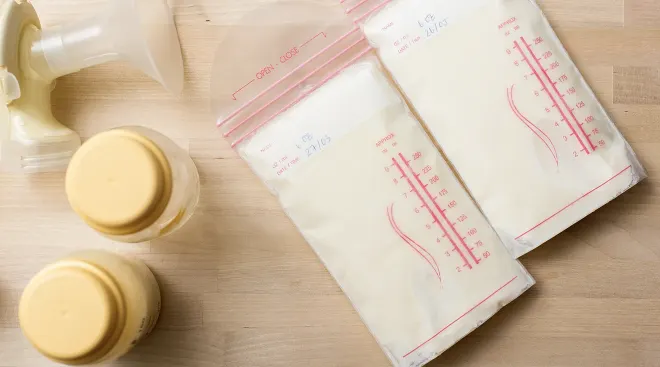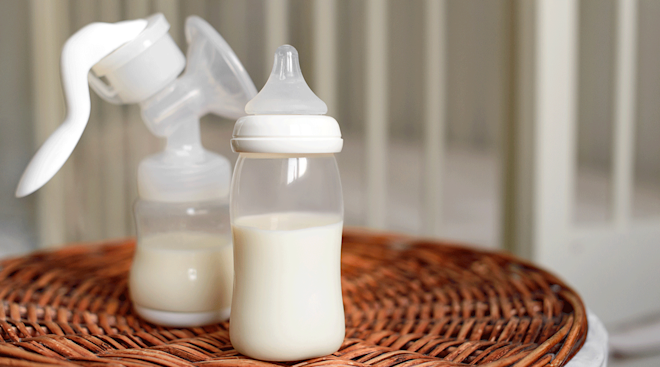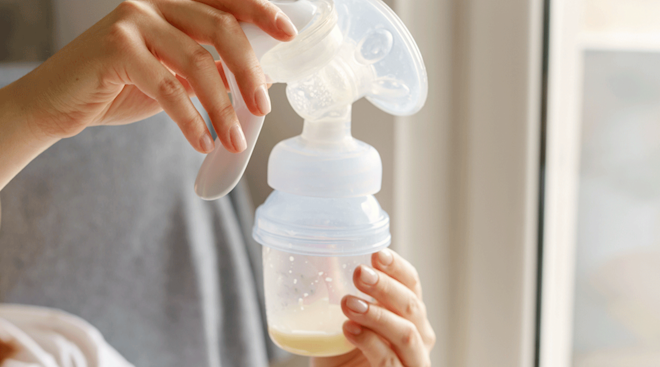A Smart Start

Experts agree: Breast milk is one of the greatest gifts you can give your baby. It’s brimming with nutrients and antibodies that boost your newborn’s immunity, aid digestion and promote brain development. An added bonus: Breastfeeding burns calories like crazy, helping you lose those pregnancy pounds faster. And it reduces your lifetime risk of developing breast or ovarian cancer and postmenopausal osteoporosis.
But good things don’t always come easily. Marathon feeding sessions, engorged breasts and sore nipples are some of the challenges you might face as a nursing mom, especially in the beginning. Fortunately, the vast majority of problems can be overcome with information and practice, says Sue Tiller, R.N., an international board-certified lactation consultant in Centreville, Va., and author of Breastfeeding 101: A Step-by-Step Guide to Successfully Nursing Your Baby (TLC Publishing). The first week is particularly crucial, Tiller adds—that’s when you and your baby learn the ropes and your milk supply is established.
We’re here to help. From how to position your little one at the breast to the best time for introducing a bottle, we’ll tell you what you need to know to get off to the right start and avoid pitfalls during those pivotal early days.
Hop To It
Immediately after giving birth, you may be dying to devour a pizza or call loved ones with your news. But that’s when newborns tend to be the most alert and responsive, making it the ideal time to introduce your baby to the breast, Tiller says. After a vaginal delivery, as long as there are no complications, try to nurse right away. If you’ve had a Cesarean section, you may have to wait until surgery is complete—but try to breastfeed within the first hour.
Don’t stress if your baby doesn’t nurse at first; unless she’s a preemie, she shouldn’t need much nourishment for the first few days. (Babies born at term have stores of calories and fluid that make it unnecessary for them to eat much early on.)
Make Sure You’re Comfy
Once your baby is latched onto your breast and nursing contentedly, you won’t want to interrupt her because your back hurts or your arm is tired. So take a minute to settle into a comfortable, relaxed position before starting to breastfeed, advises Terriann Shell, an international board-certified lactation consultant in Big Lake, Alaska.
When you’re just starting out, sit up straight in an armchair or your hospital bed. (Once you and your baby get the hang of nursing, you can try other positions, such as lying on your side.) Lay a firm pillow across your lap so your baby is level with your breast, and prop up your elbows on the chair arms or pillows. (You also can use pillows that are made specifically for breastfeeding; see “Breast Buddies,” below, for our expert’s picks.) Also put a pillow behind your back for support, if needed. If you’re sitting in a chair, place your feet on a small stool to bring your baby closer and help prevent back and arm strain.
Learn The Correct Latch
A good latch is essential for your milk to flow properly and to keep your little piranha from making fish food of your nipples. Before you put her to the breast, make sure your baby is on her side so you and she are belly to belly, Shell advises. When she does latch on, her mouth should be opened wide, like a yawn, and take in a good portion of your areola. (For detailed instructions and photos, visit .)
Let Your Baby Graze
Frequent and effective nursing is key to boosting your milk supply and ensuring that your newborn gets enough to eat. You should aim for at least eight to 12 feedings daily—about every two to three hours—for the first few weeks, says Jane Morton, M.D., director of the breastfeeding medicine program at Lucile Packard Children’s Hospital at Stanford University in Palo Alto, Calif. At first, each nursing session could last anywhere from 20 to 45 minutes; as your milk production increases and your baby gets better at suckling, it shouldn’t take as long. The number of feedings will also decrease.
In the first weeks, when your baby is more sleepy than hungry, you may have to initiate many of these feedings—even if it means waking her in the wee hours. If she falls asleep within minutes of latching on, you can try rousing her by changing her diaper or undressing her. But if she seems to be gaining weight appropriately, you don’t need to.
Hold Off On Bottles
While you may love the idea of pumping some extra milk and letting your partner take over one of those middle-of-the-night feedings, hold off on introducing a bottle (or a pacifier, for that matter) for a month or so, until breastfeeding is well established, Morton advises. Since it’s easier to extract milk from an artificial nipple, giving a bottle too early could cause your baby to reject the breast in favor of the bottle’s faster flow. But don’t make the mistake of waiting too long, either. “Babies tend to be open-minded at about 4 weeks of age,” Morton says. “If you wait much longer, you may have trouble getting her to take a bottle.”
Know What’s Normal
Having the right information will keep you from worrying unnecessarily—and if you do have a problem, you can nip it in the bud. Here’s what to expect:
Yellow “milk” Until your milk comes in (usually three to four days postpartum), you’ll be producing small amounts of colostrum, a thick, yellowish substance that’s extra-rich in antibodies and easy to digest—the perfect food for a newborn. Because it’s brimming with protective nutrients, your baby doesn’t need much—only about a teaspoon per feeding.
Engorged breasts Just when you thought your boobs couldn’t get any bigger, your milk kicks in, causing them to swell to porn-star proportions. If you’re nursing frequently and effectively, this engorgement—along with any tenderness—should subside within a few days (though you may become engorged at any time if your baby goes longer than usual between feedings).
In the meantime, try expressing some milk by hand or with a pump; or apply a warm compress before nursing to make it easier for your baby to latch on. After nursing, insert ice packs or bags of frozen peas in your bra to minimize swelling (wrap them in damp paper towels or thin dishtowels to protect your skin). Or try cold cabbage leaves, an ancient Chinese remedy that relieves engorgement in some women. But only use them briefly before nursing to get your milk flowing, Shell advises.
Sore nipples Some mild soreness is common in the first week or so and can be soothed by applying a touch of expressed breast milk, medical-grade lanolin (unless you have a wool allergy) or an all-natural ointment such as Motherlove Nipple Cream. But severe pain, bleeding or cracking are signs your baby isn’t latching on correctly—so get help from a lactation consultant ASAP.
Leaking and spraying It may take several weeks for your milk-production system to regulate itself. Until then, you may feel like Old Faithful—leaking, spraying and dripping breast milk at inopportune times. Though inconvenient, it’s perfectly normal and indicates that you’re producing plenty of milk. To avoid stains, wear disposable or washable cotton nursing pads and change them often. Avoid plastic breast shields and plastic-lined pads, which collect moisture rather than absorb it.
Don’t Go It Alone
New moms who get plenty of support and guidance tend to breastfeed longer than those who don’t (and experts recommend exclusive breastfeeding for the first six months and continued breastfeeding for at least one year). The best time to seek help? Before you need it. While you’re in the hospital, spend time with the lactation consultant on staff. If your hospital doesn’t have such an expert on-site, your nurse or pediatrician may be able to help.
After heading home, attend a breastfeeding support group (offered through some hospitals and La Leche League International: 800-525-3243, ilca.org). In addition, the International Lactation Consultant Association (919-861-5577, ilca.org) can provide valuable information or help you find a board-certified lactation consultant in your area.
Breast Buddies
You don’t need a lot of fancy equipment to successfully breastfeed your baby, but you may find it easier or more comfortable with these helpful products, recommended by certified lactation consultant Corky Harvey, R.N., co-founder of The Pump Station, a breastfeeding resource center in Santa Monica and Hollywood, Calif.
Nursing pillow
One of these specially designed pillows can help you position your baby correctly and stay comfy. For longer-waisted women, Harvey suggests the Bosom Baby Nursing Pillow ( amazon.com), as its V-shape fits postpartum moms’ waists well. If you’re short-waisted, My Brest Friend ( mybrestfriend.com) may be a better fit. And with its new stretch waist panel feature, Boppy ( boppy.com) is still a favorite of many. Got two on the way? Moms of multiples swear by Double Blessings’ EZ-2-Nurse Twins ( doubleblessings.com).
Nursing bra
A good nursing bra eliminates the need to undress every time you breastfeed and provides crucial support. For the first few weeks, a soft, stretchy “transitional” bra, such as Bravado! Designs Original Nursing Bra bravadodesigns.com, offers comfort and room to grow. After the engorgement period, a more supportive bra, like Elle Macpherson Intimates Maternelle Nursing Bra pumpstation.com or Medela’s Seamless Maternity/Nursing Bra ( medela.com), or a nursing camisole such as Glamourmom Nursing Bra Tank ( glamourmom.com) is a great option. Don’t wear underwire bras during the first few weeks, as they can cause plugged ducts.
_ Nursing pads _
You never know when you’ll spring a leak, so load up on these babies. Opt for disposable (like Lansinoh Disposable Nursing Pads, lansinoh.com) or reusable (such as Medela 100% Cotton Washable Bra Pads, medela.com).
Glycerin gel pads
For sore, cracked nipples, nothing’s better than Soothies glycerin gel pads ( amazon.com), which provide cooling relief and can help speed healing. Just slip them in the fridge before you start nursing, then reinsert in your bra when you’re done.
Nursing coverup
If you’re nervous about public displays, a chic nursing coverup like Bebe au Lait ( bebeaulait.com) is for you.
—Stacy Whitman, for FitPregnancy. Read more great articles on FitPregnancy.com.
Please note: The Bump and the materials and information it contains are not intended to, and do not constitute, medical or other health advice or diagnosis and should not be used as such. You should always consult with a qualified physician or health professional about your specific circumstances.
Navigate forward to interact with the calendar and select a date. Press the question mark key to get the keyboard shortcuts for changing dates.




















































